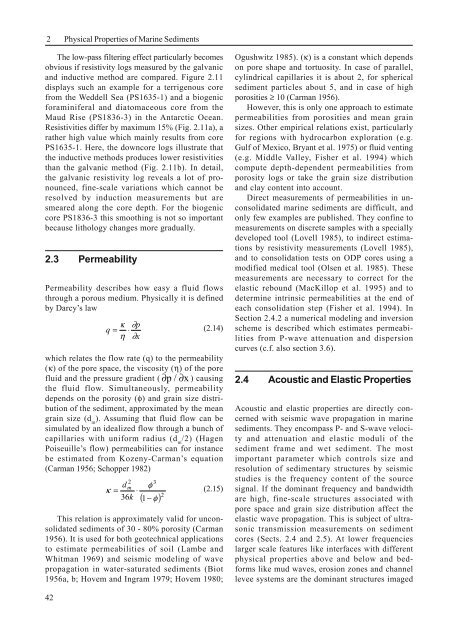2 Physical Properties of Marine Sediments - Blogs Unpad
2 Physical Properties of Marine Sediments - Blogs Unpad
2 Physical Properties of Marine Sediments - Blogs Unpad
You also want an ePaper? Increase the reach of your titles
YUMPU automatically turns print PDFs into web optimized ePapers that Google loves.
2<strong>Physical</strong> <strong>Properties</strong> <strong>of</strong> <strong>Marine</strong> <strong>Sediments</strong>The low-pass filtering effect particularly becomesobvious if resistivity logs measured by the galvanicand inductive method are compared. Figure 2.11displays such an example for a terrigenous corefrom the Weddell Sea (PS1635-1) and a biogenicforaminiferal and diatomaceous core from theMaud Rise (PS1836-3) in the Antarctic Ocean.Resistivities differ by maximum 15% (Fig. 2.11a), arather high value which mainly results from corePS1635-1. Here, the downcore logs illustrate thatthe inductive methods produces lower resistivitiesthan the galvanic method (Fig. 2.11b). In detail,the galvanic resistivity log reveals a lot <strong>of</strong> pronounced,fine-scale variations which cannot beresolved by induction measurements but aresmeared along the core depth. For the biogeniccore PS1836-3 this smoothing is not so importantbecause lithology changes more gradually.2.3 PermeabilityPermeability describes how easy a fluid flowsthrough a porous medium. <strong>Physical</strong>ly it is definedby Darcy’s lawκ ∂pq = ⋅(2.14)η ∂xwhich relates the flow rate (q) to the permeability(κ) <strong>of</strong> the pore space, the viscosity (η) <strong>of</strong> the porefluid and the pressure gradient ( ∂p/ ∂x) causingthe fluid flow. Simultaneously, permeabilitydepends on the porosity (φ) and grain size distribution<strong>of</strong> the sediment, approximated by the meangrain size (d m). Assuming that fluid flow can besimulated by an idealized flow through a bunch <strong>of</strong>capillaries with uniform radius (d m/2) (HagenPoiseuille’s flow) permeabilities can for instancebe estimated from Kozeny-Carman’s equation(Carman 1956; Schopper 1982)23φκ =d m ⋅(2.15)36kφ( 1−) 2This relation is approximately valid for unconsolidatedsediments <strong>of</strong> 30 - 80% porosity (Carman1956). It is used for both geotechnical applicationsto estimate permeabilities <strong>of</strong> soil (Lambe andWhitman 1969) and seismic modeling <strong>of</strong> wavepropagation in water-saturated sediments (Biot1956a, b; Hovem and Ingram 1979; Hovem 1980;Ogushwitz 1985). (κ) is a constant which dependson pore shape and tortuosity. In case <strong>of</strong> parallel,cylindrical capillaries it is about 2, for sphericalsediment particles about 5, and in case <strong>of</strong> highporosities ≥ 10 (Carman 1956).However, this is only one approach to estimatepermeabilities from porosities and mean grainsizes. Other empirical relations exist, particularlyfor regions with hydrocarbon exploration (e.g.Gulf <strong>of</strong> Mexico, Bryant et al. 1975) or fluid venting(e.g. Middle Valley, Fisher et al. 1994) whichcompute depth-dependent permeabilities fromporosity logs or take the grain size distributionand clay content into account.Direct measurements <strong>of</strong> permeabilities in unconsolidatedmarine sediments are difficult, andonly few examples are published. They confine tomeasurements on discrete samples with a speciallydeveloped tool (Lovell 1985), to indirect estimationsby resistivity measurements (Lovell 1985),and to consolidation tests on ODP cores using amodified medical tool (Olsen et al. 1985). Thesemeasurements are necessary to correct for theelastic rebound (MacKillop et al. 1995) and todetermine intrinsic permeabilities at the end <strong>of</strong>each consolidation step (Fisher et al. 1994). InSection 2.4.2 a numerical modeling and inversionscheme is described which estimates permeabilitiesfrom P-wave attenuation and dispersioncurves (c.f. also section 3.6).2.4 Acoustic and Elastic <strong>Properties</strong>Acoustic and elastic properties are directly concernedwith seismic wave propagation in marinesediments. They encompass P- and S-wave velocityand attenuation and elastic moduli <strong>of</strong> thesediment frame and wet sediment. The mostimportant parameter which controls size andresolution <strong>of</strong> sedimentary structures by seismicstudies is the frequency content <strong>of</strong> the sourcesignal. If the dominant frequency and bandwidthare high, fine-scale structures associated withpore space and grain size distribution affect theelastic wave propagation. This is subject <strong>of</strong> ultrasonictransmission measurements on sedimentcores (Sects. 2.4 and 2.5). At lower frequencieslarger scale features like interfaces with differentphysical properties above and below and bedformslike mud waves, erosion zones and channellevee systems are the dominant structures imaged42
















